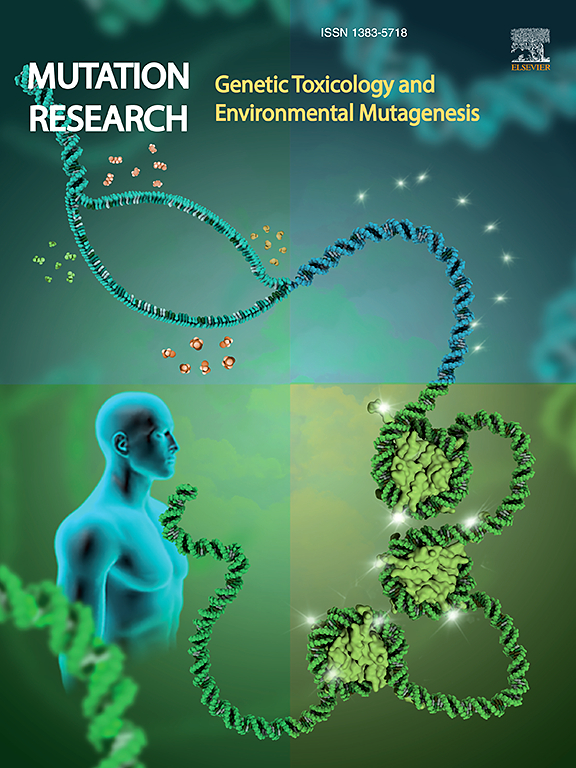聚对苯二甲酸乙二醇酯(PET)醋酸迁移液对大鼠重复剂量暴露的遗传毒性作用模式探讨
IF 2.5
4区 医学
Q3 BIOTECHNOLOGY & APPLIED MICROBIOLOGY
Mutation research. Genetic toxicology and environmental mutagenesis
Pub Date : 2025-09-09
DOI:10.1016/j.mrgentox.2025.503886
引用次数: 0
摘要
聚乙二醇对苯二甲酸乙二醇酯(PET)作为一种常用的与食品接触的材料,可能与食品发生相互作用,并且由于某些成分可以迁移,这已经成为食品安全问题。本研究旨在通过体内多终点遗传毒性评价系统和定量肝脏蛋白质组学分析,探讨PET乙酸迁移液的遗传毒性及其毒性作用方式。48只雄性Sprague-Dawley大鼠随机分为8组:PET乙酸迁移液组、乙酸组、磷酸盐缓冲盐水(PBS)对照组、n -乙基-n -亚硝基脲(ENU)阳性对照组及相应的卫星组。PBS和ENU灌胃,PET醋酸迁移液和醋酸灌胃。暴露时间为35天,恢复期为15天。PET醋酸迁移液可引起大鼠心、肝、肾损伤。第15天,在猪-a基因测试中发现了突变。第35天,外周血和肝细胞均出现DNA损伤。肝脏蛋白质组学的基因本体(GO)分析揭示了DNA代谢和结合过程的富集,而京都基因与基因组百科全书(KEGG)分析则强调了DNA复制途径。免疫组织化学分析显示,PET醋酸迁移液组8-羟基脱氧鸟苷(8-OHdG)显著增加,单链结合(SSB)蛋白显著减少。综上所述,PET乙酸迁移液可能通过抑制DNA复制和DNA修复途径诱导DNA损伤。然而,遗传毒性的可能性很低。本文章由计算机程序翻译,如有差异,请以英文原文为准。
Genotoxicity mode of action exploration of polyethylene glycol terephthalate (PET) acetic acid migration solution under repeated-dose exposure in rats
As a commonly used material that contacts food, polyethylene glycol terephthalate (PET) may interact with food, and since certain components can migrate, this has become a food safety concern. This study aims to investigate the genotoxicity of PET acetic acid migration solution and its toxic mode of action using an in vivo multi-endpoint genotoxicity evaluation system and quantitative liver proteomics analysis. Forty-eight male Sprague–Dawley rats were randomly divided into eight groups: the PET acetic acid migration solution group, the acetic acid group, the phosphate-buffered saline (PBS) control group, the N-ethyl-N-nitrosourea (ENU) positive control group, and their corresponding satellite groups. PBS and ENU were administered by gavage, while the PET acetic acid migration solution and acetic acid were administered orally in the drinking water. The exposure duration was 35 days, followed by a recovery period of 15 days. The PET acetic acid migration solution can cause heart, liver, and kidney injury in rats. On the 15th day, mutations were seen in the Pig-a gene test. On the 35th day, DNA damage was observed in peripheral blood and liver cells. Gene ontology (GO) analysis of the liver proteomics revealed enrichment in DNA metabolism and binding processes, while Kyoto Encyclopedia of Genes and Genomes (KEGG) analysis highlighted the DNA replication pathway. Immunohistochemical analysis demonstrated a significant increase in 8-hydroxydeoxyguanosine (8-OHdG) and a decrease in single-stranded-binding (SSB) protein in the PET acetic acid migration solution group. In summary, the PET acetic acid migration solution has the potential to induce DNA damage, possibly by inhibiting DNA replication and DNA repair pathways. However, the likelihood of genetic toxicity is low.
求助全文
通过发布文献求助,成功后即可免费获取论文全文。
去求助
来源期刊
CiteScore
3.80
自引率
5.30%
发文量
84
审稿时长
105 days
期刊介绍:
Mutation Research - Genetic Toxicology and Environmental Mutagenesis (MRGTEM) publishes papers advancing knowledge in the field of genetic toxicology. Papers are welcomed in the following areas:
New developments in genotoxicity testing of chemical agents (e.g. improvements in methodology of assay systems and interpretation of results).
Alternatives to and refinement of the use of animals in genotoxicity testing.
Nano-genotoxicology, the study of genotoxicity hazards and risks related to novel man-made nanomaterials.
Studies of epigenetic changes in relation to genotoxic effects.
The use of structure-activity relationships in predicting genotoxic effects.
The isolation and chemical characterization of novel environmental mutagens.
The measurement of genotoxic effects in human populations, when accompanied by quantitative measurements of environmental or occupational exposures.
The application of novel technologies for assessing the hazard and risks associated with genotoxic substances (e.g. OMICS or other high-throughput approaches to genotoxicity testing).
MRGTEM is now accepting submissions for a new section of the journal: Current Topics in Genotoxicity Testing, that will be dedicated to the discussion of current issues relating to design, interpretation and strategic use of genotoxicity tests. This section is envisaged to include discussions relating to the development of new international testing guidelines, but also to wider topics in the field. The evaluation of contrasting or opposing viewpoints is welcomed as long as the presentation is in accordance with the journal''s aims, scope, and policies.

 求助内容:
求助内容: 应助结果提醒方式:
应助结果提醒方式:


